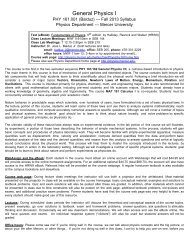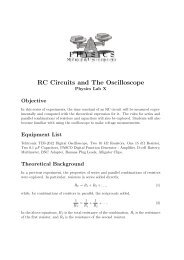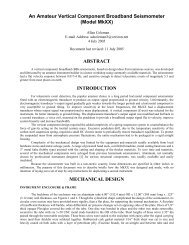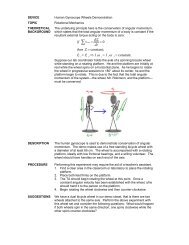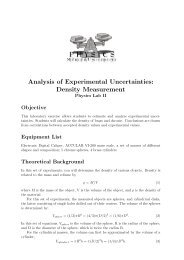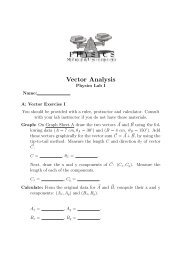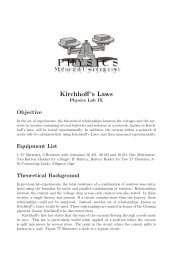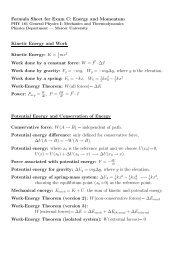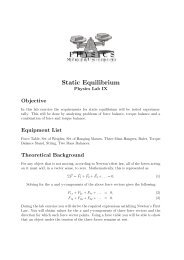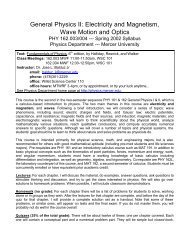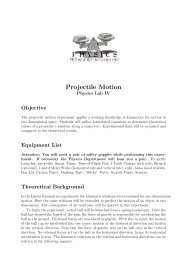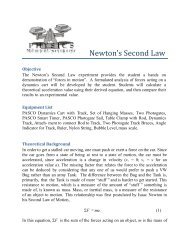Amateur Horizontal Component Seismometer, with Passive Leveling ...
Amateur Horizontal Component Seismometer, with Passive Leveling ...
Amateur Horizontal Component Seismometer, with Passive Leveling ...
You also want an ePaper? Increase the reach of your titles
YUMPU automatically turns print PDFs into web optimized ePapers that Google loves.
ELECTRONICS<br />
General:<br />
There were two separate hand-wired boards, the Displacement Transducer Circuit Board (DTCB) and the Feedback<br />
Circuit Board (FCB). The DTCB was segregated to one aluminum project box, and the sensitive analog circuits of the FCB in<br />
another. An off-the-shelf +/-12 VDC, dual linear supply (1 amp per side), powered the circuit boards.<br />
Circuits were constructed using metal film resistors <strong>with</strong> 1% tolerances, for all values up to 1 meg ohm. Larger values<br />
were carbon types <strong>with</strong> 5% tolerances. All power decoupling caps and feedback cap values under .01 microfarad were ceramic,<br />
all others >.01 mF were polyester. The circuits were built on perforated boards <strong>with</strong> sockets for all ICs. To reduce power rail<br />
noise, the power pins on all op amps were wired via 20-Ohm resistors to a common point on the output pins of the voltage<br />
regulators. To eliminate or significantly reduce ground loops, a small piece of adhesive backed copper foil 3 mm wide by 20<br />
mm long was attached to the underside of the perf board, between the rows of legs of each op amp socket. Decoupling caps and<br />
other components associated <strong>with</strong> each op amp requiring grounding were soldered to the piece of foil. Then each individual foil<br />
was connected directly to a common ground point on the circuit board, no daisy chaining. Also, .01 mF ceramic decoupling<br />
caps were inserted where power-carrying wires entered a circuit board. A short length of coax cable connected the output of the<br />
DTCB to the FCB. The coax outer shield was connected to the metal project boxes. Any flux residues seen built up on the<br />
circuit boards, extending between conductors, were scraped off as best as possible to reduce potential signal leakage.<br />
Displacement Transducer Circuit Board (DTCB):<br />
Adjustable voltage regulators U1 and U2 (Figure 7) filtered and stepped down the voltage from the common supply,<br />
providing the circuits <strong>with</strong> +/-10 VDC. With 10 mF Tantalum capacitors connected to the regulators, better than 65dB ripple<br />
and spike rejection was possible. The IN4002 diodes protected the regulators from excess voltages during power down.<br />
Function generator U3 (Figure 8) had a total harmonic distortion of 2-3% and similar tolerance for the frequency<br />
stability and produced a 5.4 KHz sine wave output signal. Precision DC operational amplifiers have increasing noise towards<br />
the lower frequencies, so operating the transducer <strong>with</strong> a reasonably high AC frequency reduced the 1/f noise problem. Sine<br />
wave was filtered and buffered by op amp U4 <strong>with</strong> a 4X gain to increase P-P value. An audio transformer T1 (Digi-Key P/N<br />
237-1121-ND) <strong>with</strong> 600-600 ohm center tapped coils were referenced to ground for DC common-mode voltage rejection. The<br />
secondary coils produced two modulating signals, 180 degrees out of phase <strong>with</strong> each other and connected to the active areas<br />
on the SDC’s moving inner plates, PA and PB, per the diagonally opposing pattern shown in Figure 8.<br />
Op amp U5 is a zero-crossing detector referenced to ground for converting the AC sine wave into a sharp square<br />
wave, oscillating from 0 to +10 volts. A divider lowered the triggering voltage seen by the demodulator’s analog switch U8 to<br />
+3.8 volts max. Active areas on the capacitor’s fixed outer plates, PC and PD detected the modulated voltage signal’s amplitude<br />
and phase in proportion to the displacement of the inner plates, in either direction from their null position. High impedance<br />
unity gain amplifiers, op amps U6 and U7, drove guards (the coax outer shield) to reduce stray input capacitance for additional<br />
sensitivity, plus the input pins to these op amps were bootstrapped for circuit stability. Their outputs were fed into the analog<br />
switch U8, a demodulator synchronized <strong>with</strong> the sine wave signal from U4, monitoring the modulated voltage of each half<br />
cycle. Op amp U9, an instrumentation amplifier (IA) <strong>with</strong> 418X gain, differentiated the signal from the SDC. Coax audio<br />
cables half a meter long were soldered to the SDC, and connected to the circuit board via RCA phono plugs. The outer shields<br />
of the two inner plate’s coaxes were atached to chassis ground.<br />
Feedback Circuit Board (FCB):<br />
Adjustable voltage regulators U1 and U2 (Figure 7), including their associated components were duplicated on this<br />
board to supply filtered +/- 10 VDC to the circuit.<br />
Referring now to Figure 9, op amp U10 is configured as a special integrator <strong>with</strong> the intended purpose of improving<br />
low frequency sensitivity and stability. Such an “integrator” appeared in papers writen by Erhard Wielandt [7][8][9], seen<br />
adjacent to the displacement transducer in block diagrams representing the electronic circuitry of Streckeisen seismometers.<br />
Erhard Wielandt, via personal communications, explained that because the system would oscillate if high gain is maintained at<br />
high frequencies, loop gain had to be frequency-dependent, increasing towards the low frequencies while ensuring unity gain at<br />
the higher frequencies. One way to realize this is to insert a special integrator or quasi-integrator, <strong>with</strong>in the feedback loop.<br />
Based on the word description he provided and after some experimentation, a workable circuit design evolved. A 1 st order 34<br />
Hz LPF attenuated high frequency circuit noise from the displacement transducer prior to entering the quasi-integrator. Op amp<br />
10 is a unity gain instrumentation amplifier (IA) <strong>with</strong> high impedance FET inputs and excellent common mode rejection<br />
(CMR) to differentiate between small input signals. A 2 nd order 3.5 Hz high pass filter (HPF) comprising of C2, C3, R2 and R3<br />
was inserted into the integrator’s feedback loop between pins 2 and 6 of the IA. A buffer op amp U11 installed after the<br />
integrator prevented any unwanted loading of downstream circuits. A temporary shunt was installed across the capacitors C2<br />
and C3 when the system was calibrated and removed later for normal operation.<br />
The multi-path feedback circuit followed a schematic published by Sean-Thomas Morrissey for his vertical<br />
component VBB seismometer, the STM-8 [10], which itself was based on similar circuits found on VBB seismometers. Multipath<br />
feedback is a combination of differential and integral feedback signals flowing through the feedback transducer mounted<br />
on the pendulum. The differential signal dominates across the passband of interest, decreasing towards the lower frequencies<br />
4



